19376 chinese immigration in theusa
Bạn đang xem bản rút gọn của tài liệu. Xem và tải ngay bản đầy đủ của tài liệu tại đây (61.8 KB, 3 trang )
We lived in Oakland's Chinatown from 1933
to 1948. Chinatown was a small enclave of four
square blocks. Like us, most of the Chinese living
here spoke the Toishan dialect because they came
from the Pearl River Delta of Guangdong Province in southern China.
We attended American school and concentrated on learning
English.
All the children in our neighborhood attended Lincoln Grammar
School, a school within walking distance from Chinatown. The student
body was made up of mostly Chinese, some Caucasians and a few
Japanese. The students spoke Chinese and English. The new
immigrants were put in limited-English- proficiency classes and
received extra help. Sister Li Hong and I were assigned to these
classes. Slowly we started to learn English.
We attended Chinese school after American school each day. We
had very little time to play or to get into mischief. There was very
little money during the Depression years. Even though life was hard,
we loved being Americans.
Although we were now Americans, we did not know many
Caucasian Americans except for the teachers at school. We socialized
with the other Chinese Americans in Chinatown. Chinese Americans
were not allowed to buy property in certain areas of Oakland because
of racial prejudice. We were also not allowed to do certain jobs like
law enforcement, government work, and many professions. Because
of these restrictions, many Chinese opened restaurants, grocery
stores, and laundries.
My father was one of those people. During World War II, my
father opened a restaurant in Oakland's Chinatown. We children all
worked in that restaurant — from waiting on tables to mopping the
floor. We never got paid because, as a family business, we worked to
make the restaurant succeed. The entire family worked seven days a
week. Our hard work paid off when in 1948 we were able to purchase
a home outside of Chinatown.
/>
A- ANSWER THESE QUESTIONS ACCORDING TO THE TEXT:
1. How long did they live in Oakland’s Chinatown?
2. How does the author describe it?
3. Which language/dialect did they speak? Why?
4. Who attend their school?
5. Which type of English classes did the new immigrants attend?
Why?
B – COMPLETE THESE SENTENCES ON THE TEXT:
1. Despite
leading
a
difficult
life,
children
______________________________
2. They
socialized
mostly
with
_______________________________________
3. They were not allowed to ________________________ due to
___________
4. As
there
were many restrictions, Chinese had
to
open
__________________
5. All the family had to work at the restaurant in order to
________________
6. Despite working hard, later on his family was able to
__________________
C - WHO / WHAT DO THE UNDERLINED WORDS REFER TO?
1. They ______________
2. These _____________
3. We _______________
4. Those _____________








